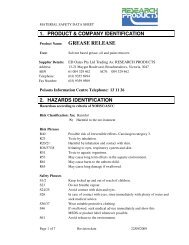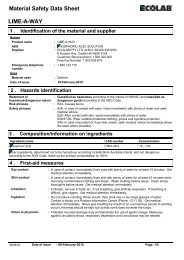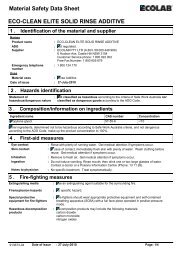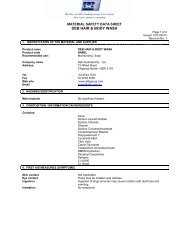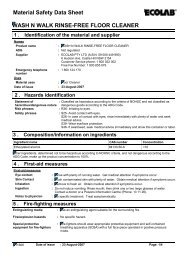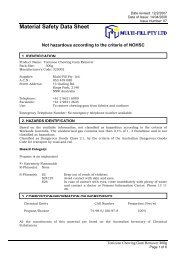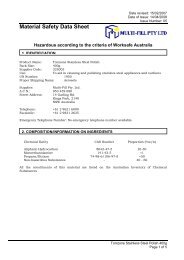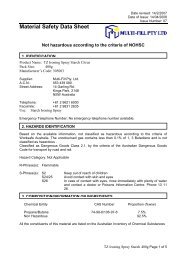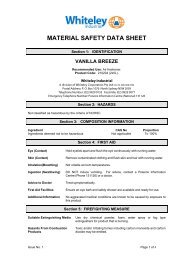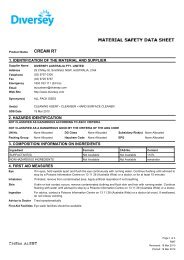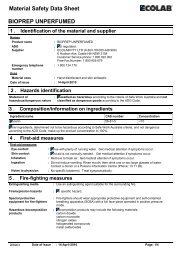MSDS - Big Bare 2010 - Melbourne Cleaning Supplies
MSDS - Big Bare 2010 - Melbourne Cleaning Supplies
MSDS - Big Bare 2010 - Melbourne Cleaning Supplies
Create successful ePaper yourself
Turn your PDF publications into a flip-book with our unique Google optimized e-Paper software.
Product Name<br />
BIG BARE<br />
1. IDENTIFICATION OF THE MATERIAL AND SUPPLIER<br />
Supplier Name<br />
Address<br />
Telephone<br />
Fax<br />
Emergency<br />
Email<br />
Web Site<br />
Synonym(s)<br />
DIVERSEY AUSTRALIA PTY. LIMITED<br />
29 Chifley St, Smithfield, NSW, AUSTRALIA, 2164<br />
(02) 9757 0300<br />
(02) 9725 5767<br />
1800 033 111 (24 hrs)<br />
aucustserv@diversey.com<br />
http://www.diversey.com<br />
HH15479 BIG BARE 4X5L<br />
Use(s)<br />
SDS Date<br />
CLEANING AGENT • DEGREASER • DEGREASING AGENT<br />
08 Mar <strong>2010</strong><br />
2. HAZARDS IDENTIFICATION<br />
CLASSIFIED AS HAZARDOUS ACCORDING TO ASCC CRITERIA<br />
RISK PHRASES<br />
R36<br />
Irritating to eyes.<br />
SAFETY PHRASES<br />
S2<br />
Keep out of reach of children.<br />
S25<br />
Avoid contact with eyes.<br />
NOT CLASSIFIED AS A DANGEROUS GOOD BY THE CRITERIA OF THE ADG CODE<br />
UN No.<br />
Packing Group<br />
None Allocated DG Class None Allocated Subsidiary Risk(s) None Allocated<br />
None Allocated Hazchem Code None Allocated EPG<br />
None Allocated<br />
3. COMPOSITION/ INFORMATION ON INGREDIENTS<br />
Ingredient Formula CAS No. Content<br />
SODIUM METASILICATE ANHYDROUS Na2-Si-O3 6834-92-0 60%<br />
BUILDER Not Available Not Available
Product Name<br />
Advice to Doctor<br />
BIG BARE<br />
Treat symptomatically<br />
5. FIRE FIGHTING MEASURES<br />
Flammability<br />
Fire and<br />
Explosion<br />
Extinguishing<br />
Hazchem Code<br />
Non flammable. May evolve toxic gases if strongly heated.<br />
No fire or explosion hazard exists.<br />
Prevent contamination of drains or waterways.<br />
None Allocated<br />
6. ACCIDENTAL RELEASE MEASURES<br />
Spillage<br />
Use personal protective equipment. Contain spillage, then cover / absorb spill with non-combustible absorbant<br />
material (vermiculite, sand, or similar), collect and place in suitable containers for disposal. CAUTION: Spill site<br />
may be slippery.<br />
7. STORAGE AND HANDLING<br />
Storage<br />
Handling<br />
Store in a cool, dry, well ventilated area, removed from oxidising agents, acids and foodstuffs. Ensure containers<br />
are adequately labelled, protected from physical damage and sealed when not in use. Check regularly for leaks or<br />
spills.<br />
Before use carefully read the product label. Use of safe work practices are recommended to avoid eye or skin<br />
contact and inhalation. Observe good personal hygiene, including washing hands before eating. Prohibit eating,<br />
drinking and smoking in contaminated areas.<br />
8. EXPOSURE CONTROLS/ PERSONAL PROTECTION<br />
Exposure Stds<br />
No exposure standard(s) allocated.<br />
Biological Limits<br />
Engineering<br />
Controls<br />
PPE<br />
No biological limit allocated.<br />
Avoid inhalation. Use in well ventilated areas. Where an inhalation risk exists, mechanical extraction ventilation is<br />
recommended.<br />
Wear splash-proof goggles and rubber or PVC gloves. When using large quantities or where heavy contamination<br />
is likely, wear: coveralls.<br />
9. PHYSICAL AND CHEMICAL PROPERTIES<br />
Appearance CLEAR PALE YELLOW LIQUID Solubility (Water) SOLUBLE<br />
Odour ODOURLESS Specific Gravity 1.144 (Approximately)<br />
pH 12.8 - 13.8 % Volatiles > 60 % (Water)<br />
Vapour Pressure 18 mm Hg @ 20°C Flammability NON FLAMMABLE<br />
Vapour Density NOT AVAILABLE Flash Point NOT RELEVANT<br />
Boiling Point 100°C (Approximately) Upper Explosion Limit NOT RELEVANT<br />
Melting Point < 0°C Lower Explosion Limit NOT RELEVANT<br />
Evaporation Rate<br />
AS FOR WATER<br />
10. STABILITY AND REACTIVITY<br />
Chemical Stability Stable under recommended conditions of storage.<br />
Conditions to Avoid Avoid heat, sparks, open flames and other ignition sources.<br />
Material to Avoid Incompatible with oxidising agents (eg. hypochlorites) and acids (eg. nitric acid).<br />
Decomposition<br />
May evolve toxic gases if heated to decomposition.<br />
Hazardous Reactions Polymerization is not expected to occur.<br />
Page 2 of 4<br />
RMT<br />
Reviewed: 08 Mar <strong>2010</strong><br />
Printed: 10 Mar <strong>2010</strong>
Product Name<br />
BIG BARE<br />
11. TOXICOLOGICAL INFORMATION<br />
Health Hazard<br />
Summary<br />
Eye<br />
Inhalation<br />
Skin<br />
Ingestion<br />
This product has the potential to cause adverse health effects with over exposure. Use safe work practices to<br />
avoid eye or skin contact and inhalation. Due to the low vapour pressure of this product, an inhalation hazard is<br />
not anticipated with normal use.<br />
Contact may result in irritation, lacrimation, pain, redness, conjunctivitis and possible burns.<br />
Over exposure may result in irritation of the nose and throat, coughing, nausea and headache. Due to the low<br />
vapour pressure, an inhalation hazard is not anticipated with normal use.<br />
Contact may result in irritation, redness, pain, rash, dermatitis and possible burns.<br />
Ingestion may result in ulceration and burns to the mouth and throat, nausea, vomiting, abdominal pain and<br />
diarrhoea.<br />
Toxicity Data SODIUM METASILICATE ANHYDROUS (6834-92-0)<br />
LD50 (Ingestion): 770 mg/kg (mouse)<br />
LDLo (Ingestion): 250 mg/kg (dog)<br />
LDLo (Intraperitoneal): 200 mg/kg (guinea pig)<br />
TDLo (Ingestion): 15 g/kg (rat)<br />
12. ECOLOGICAL INFORMATION<br />
Environment<br />
WATER: If released to waterways, alkaline products may change the pH of the waterway. Fish will die if the pH<br />
reaches 10-11 (goldfish 10.9, bluegill 10.5). SOIL: May leach to groundwater with toxic effects on aquatic life as<br />
above. ATMOSPHERE: Not expected to reside in the atmosphere. Drops or particles released to atmosphere<br />
should be removed by gravity and/or be rained out.<br />
13. DISPOSAL CONSIDERATIONS<br />
Waste Disposal<br />
Legislation<br />
For small amounts absorb with sand, vermiculite or similar and dispose of to an approved landfill site. Contact the<br />
manufacturer for additional information if larger amounts are involved. Prevent contamination of drains and<br />
waterways as aquatic life may be threatened and environmental damage may result.<br />
Dispose of in accordance with relevant local legislation.<br />
14. TRANSPORT INFORMATION<br />
NOT CLASSIFIED AS A DANGEROUS GOOD BY THE CRITERIA OF THE ADG CODE<br />
Shipping Name<br />
UN No.<br />
Packing Group<br />
None Allocated<br />
None Allocated DG Class None Allocated Subsidiary Risk(s) None Allocated<br />
None Allocated Hazchem Code None Allocated EPG<br />
None Allocated<br />
15. REGULATORY INFORMATION<br />
Poison Schedule<br />
AICS<br />
16. OTHER INFORMATION<br />
Additional<br />
Information<br />
Classified as a Schedule 5 (S5) Poison using the criteria in the Standard for the Uniform Scheduling of Drugs and<br />
Poisons (SUSDP).<br />
All chemicals listed on the Australian Inventory of Chemical Substances (AICS).<br />
ABBREVIATIONS:<br />
ADB - Air-Dry Basis.<br />
BEI - Biological Exposure Indice(s)<br />
CAS# - Chemical Abstract Service number - used to uniquely identify chemical compounds.<br />
CNS - Central Nervous System.<br />
EINECS - European INventory of Existing Commercial chemical Substances.<br />
IARC - International Agency for Research on Cancer.<br />
M - moles per litre, a unit of concentration.<br />
mg/m3 - Milligrams per cubic metre.<br />
NOS - Not Otherwise Specified.<br />
NTP - National Toxicology Program.<br />
OSHA - Occupational Safety and Health Administration.<br />
pH - relates to hydrogen ion concentration using a scale of 0 (high acidic) to 14 (highly alkaline).<br />
ppm - Parts Per Million.<br />
RTECS - Registry of Toxic Effects of Chemical Substances.<br />
TWA/ES - Time Weighted Average or Exposure Standard.<br />
Page 3 of 4<br />
RMT<br />
Reviewed: 08 Mar <strong>2010</strong><br />
Printed: 10 Mar <strong>2010</strong>
Product Name<br />
BIG BARE<br />
HEALTH EFFECTS FROM EXPOSURE:<br />
It should be noted that the effects from exposure to this product will depend on several factors including: frequency<br />
and duration of use; quantity used; effectiveness of control measures; protective equipment used and method of<br />
application. Given that it is impractical to prepare a Chem Alert report which would encompass all possible<br />
scenarios, it is anticipated that users will assess the risks and apply control methods where appropriate.<br />
PERSONAL PROTECTIVE EQUIPMENT GUIDELINES:<br />
The recommendation for protective equipment contained within this Chem Alert report is provided as a guide only.<br />
Factors such as method of application, working environment, quantity used, product concentration and the<br />
availability of engineering controls should be considered before final selection of personal protective equipment is<br />
made.<br />
Report Status<br />
This document has been compiled by RMT on behalf of the manufacturer of the product and serves as the<br />
manufacturer's Safety Data Sheet ('SDS').<br />
It is based on information concerning the product which has been provided to RMT by the manufacturer or<br />
obtained from third party sources and is believed to represent the current state of knowledge as to the appropriate<br />
safety and handling precautions for the product at the time of issue. Further clarification regarding any aspect of<br />
the product should be obtained directly from the manufacturer.<br />
While RMT has taken all due care to include accurate and up-to-date information in this SDS, it does not provide<br />
any warranty as to accuracy or completeness. As far as lawfully possible, RMT accepts no liability for any loss,<br />
injury or damage (including consequential loss) which may be suffered or incurred by any person as a<br />
consequence of their reliance on the information contained in this SDS.<br />
Prepared By<br />
Risk Management Technologies<br />
5 Ventnor Ave, West Perth<br />
Western Australia 6005<br />
Phone: +61 8 9322 1711<br />
Fax: +61 8 9322 1794<br />
Email: info@rmt.com.au<br />
Web: www.rmt.com.au<br />
SDS Date: 08 Mar <strong>2010</strong><br />
End of Report<br />
Page 4 of 4<br />
RMT<br />
Reviewed: 08 Mar <strong>2010</strong><br />
Printed: 10 Mar <strong>2010</strong>



